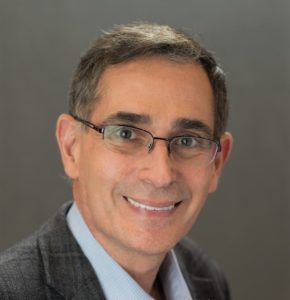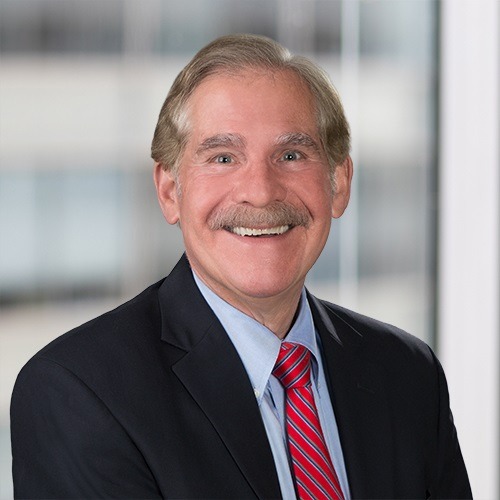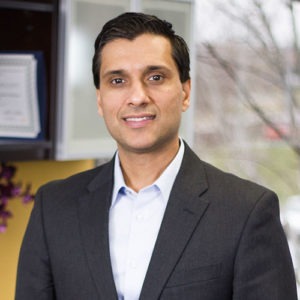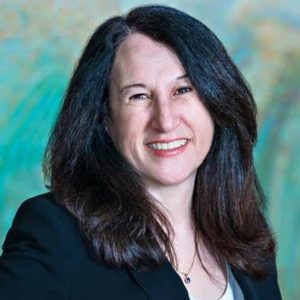View From the Trenches: Interview with Dr. Karl Steinberg, President-Elect of AMDA

Dr. Karl Steinberg
Dr. Karl Steinberg has been a hospice and nursing home medical director in San Diego County for 25 years. He is president-elect of AMDA — The Society for Post-Acute and Long-Term Care Medicine — and vice president of National POLST. Dr. Steinberg is passionate about high-quality advance care planning, geriatric and palliative care, and bioethics.
I recently had a chance to talk with him about AMDA, antibiotic stewardship, and more.
AH: You are the president-elect of AMDA, the country’s preeminent professional organization for physicians who focus their practice on the post-acute and long-term care sector. Can you briefly describe what AMDA is and touch on its history?
KS: AMDA started out as the American Medical Directors Association back in 1977, as an organization representing nursing home medical directors in the AMA and elsewhere, striving for high-quality care for the frail and vulnerable long-term care population.
Over the years, AMDA has expanded its scope to welcome not just medical directors, but other doctors, nurse practitioners, physician assistants and other professionals who practice in skilled nursing facilities — and this is reflected in our name, The Society for Post-Acute and Long-Term Care Medicine.
AH: What are your goals for AMDA as you assume its leadership?
KS: I’ve been involved on the AMDA Board and other leadership positions, including editor-in-chief of our periodical, Caring for the Ages, for decades now. It’s an honor to be stepping into the presidency in 2021, at a time that has really highlighted some of the issues we face in skilled nursing facilities. I want to continue to speak out to improve our care processes in nursing homes, make them as welcoming and homelike as possible while also elevating the medical care that’s provided in our facilities.
I would love to help educate the public, which has such a negative impression of nursing homes, about the wonderful care that’s provided there, by truly caring, compassionate, dedicated healthcare workers. And I would love to help CMS update their survey process to be less punitive and more focused toward improving actual quality in our facilities.
AH: What obstacles do you see, if any, that impact on AMDA’s ability to carry out its mission?
KS: One major obstacle is the public’s very negative impression of nursing homes, in part because virtually all of the media coverage paints facilities as terrible places.
Another obstacle is the us-versus-them mentality that seems to exist between facilities and surveyors, and facility operators and the advocacy community. It may in part be a reflection of the overall highly polarized atmosphere we are living in today, but it’s unfortunate because it makes everyone defensive — and we are only going to improve things with a concerted, collaborative effort.
Finally, there has historically been little interest in post-acute and long-term care, so our organization has had limited visibility. But in recent months with the pandemic highlighting the long-term care sector, more people are becoming interested in us — and more aware of the importance of good clinical and medical leadership in nursing homes.
AH: AMDA confers a special designation, known as the “Certified Medical Director” (CMD), for physicians who have demonstrated clinical competence. Why do you believe it is desirable, if not important, for physicians who practice in the post-acute and long-term care sector to achieve the CMD status?
KS: Depending on whom you ask, you’ll be told that the nursing home industry is either the most regulated industry in the country, or second (only to the nuclear industry). The complex and often arcane regulatory framework of nursing facilities is one of the important aspects of the CMD certificate, and many nursing home medical directors are clueless about this important area.
Also, there are many leadership and management skills that are not taught in medical school or residency, but the Core Curriculum for the CMD includes much of this — and skills like conflict resolution are very important in our nursing home work. Finally, there are far too many doctors practicing in nursing facilities who don’t even know basic geriatric medicine concepts — like deprescribing unnecessary medications, using the lowest effective doses of necessary medications, and avoiding performing unnecessary tests and procedures depending on prognosis and goals of care. A facility that hires a CMD as Medical Director can feel confident that these basic but critically important competencies will be met, to the benefit of their residents and staff alike.
AH: AMDA has developed and published a number of “Clinical Practice Guidelines.” What can you tell our readers about those CPGs?
KS: We have numerous CPGs that are updated periodically on a variety of clinical and other topics that are highly relevant to the nursing home population, and that are carefully vetted and entirely evidence-based. Facilities and medical directors who use these CPGs will be ensuring that their policies and procedures are up to date.
AH: Can you describe some of the resources AMDA provides to its members, especially regarding COVID-19?
KS: I would just direct your readers to our extensive website on the topic. It contains up-to-date information on testing, visitation, quarantining, and many other topics. I’m proud of how AMDA — unlike other organizations and agencies that will remain unnamed — got out in front of this pandemic very promptly and proactively, and in doing so certainly saved many lives.
AH: Apart from the CPGs that it develops and publishes, are there other educational tools that AMDA provides?
KS: AMDA has many other tools, both clinical and non-clinical, that can be of great benefit to post-acute and long-term care professionals. The Know-It-All tool for nurses to consult before calling a doctor with a change of condition is one that I’m fond of, and there is an Advance Care Planning template that is specific to the Post-Acute and Long-Term Care (PALTC) setting. I’d encourage anyone who’s interested to browse the website. These items are not costly and can really be helpful in caring for residents and in educating staff, residents, and families.
AH: Does AMDA interact with Centers for Medicare and Medicaid Services (CMS) on any level and, if so, what can you tell our readers about those interactions?
KS: We have regular calls with the Licensing and Certification Division of CMS, and we discuss a variety of regulatory, clinical and operational topics. AMDA appreciates that CMS recognizes us as a resource for evidence-based clinical information. We are hoping they may start looking at nursing home medical directors more carefully and ensure that facilities are hiring them for the right reasons — clinical and regulatory knowledge, leadership, etc. — and not just to refer patients to the facility.
We’re hoping that the pandemic has made the importance of competent, engaged medical directors more clear to CMS and others. Many of our AMDA state chapters interact frequently and very collaboratively with the state public health departments, and we hope to continue to build on this. A lot of people in these agencies, while well-meaning, are overly focused on regulatory compliance and lack any real-world experience in the realities of nursing home practice.
AH: Can you briefly describe the concept of antibiotic stewardship and comment on how that is affecting care in skilled nursing homes?
KS: Let me just say that the old paradigm of throwing a course of antibiotics at any nursing home resident with a change of condition has turned out to be a bad idea, and we are trying to educate others about it. The days of treating for a “possible occult UTI” should have been left behind a decade or two ago, but they still persist in some places.
Antibiotics can cause far more harm than good, and they can give a false sense of security that you’ve determined the reason for a change of condition, but it really was something else. Many people don’t understand that a lot of older patients have their bladders colonized with bacteria, but the bacteria are not doing any harm. Stewardship means that we are trying to get prescribers (and facilities) to be judicious in their ordering of cultures and especially the prescribing of antibiotics, except when a true infection is present.
AH: Several years ago, the nursing home industry made a concerted effort to reduce the frequency of prescriptions for medications. Do you think the industry has made significant positive changes?
KS: Well, if you are talking specifically about the use of antipsychotic medication, yes. The numbers have gone down by probably 30% or more in the last 8 or 10 years, and some states have done better than others. These drugs can be dangerous especially in patients with dementia, but sometimes they are helpful. We could probably get the numbers even lower, and this is something that everyone has worked together on — nursing home owners, doctors, pharmacists, nurses, advocates and others.
Lots of potentially inappropriate medications are still used in nursing homes, and sometimes medications are used off-label, meaning not FDA approved for that indication. Sometimes that is also reasonable — geriatric medicine sometimes requires trying things that there’s little evidence for, when other things fail — and there hasn’t been a ton of research done on this population.
AH: You are also the CMO of a nursing home chain. What are some of the operational issues that skilled nursing facilities face?
KS: The COVID-19 pandemic has demonstrated significant issues around how to procure PPE and testing, how to try to make sense of widely variable and constantly changing guidelines and requirements from various local and state health departments, CMS, the CDC, OSHA and others. But being part of a chain allows for scaling of initiatives, and the corporate team can learn from what’s happening in one facility and improve care processes and quality of care in all the facilities.
We had daily calls for several months with all of the administrators and directors of nursing about what was going on with COVID-19 in our buildings, and we have a dedicated COVID-19 workgroup that pores over and tries to make sense of all the disparate noise. This has proven to be of great benefit to the individual facilities and the residents we care for.
AH: How has COVID-19 affected your clinical practice as an attending physician and medical director?
KS: I think we are all just much more compulsive about infection prevention techniques and PPE. I have done virtual visits for the first time, and they usually go pretty smoothly. Finally, I am making even more of an effort than I normally do to discuss goals of care, advance care planning — because of the nuances of no-visitors policies, the trauma of going to a hospital where a patient doesn’t know anyone and the nursing staff doesn’t know them is higher than ever — and the very poor prognosis for a frail, chronically ill older patient with COVID-related respiratory failure or cardiac arrest.
AH: You also serve as the medical director of a hospice(s). Have you seen a change in hospice care as a result of COVID-19 and what trends to you foresee?
KS: Hospice care has been significantly impacted, in that hospice patients who reside in many long-term care facilities are still not being allowed to have direct visits by hospice staff, including nurses, social workers and chaplains. So much more of the care is provided virtually.
As far as COVID patients, some will prefer to avoid hospitalization, and if they develop severe respiratory symptoms, hospice is available. The trouble is that sometimes symptoms develop very rapidly. It’s important especially for nursing facilities to be forceful advocates for their residents to get comfort medications, sometimes even before hospice can get them enrolled.
AH: CMS recently, in June 2020, announced its “enhanced enforcement” policy whereby it stepped up the civil money penalties especially with respect to infection control-related deficiencies. Everyone agrees that deficiencies should be corrected as soon as possible and that facilities should be held accountable where one or more of Medicare’s Requirements of Participation were not met. Do you feel that higher and/or more frequent CMPs are the most effective way to improve resident outcomes?
KS: While I think there needs to be a “stick” for facilities that abuse or neglect their residents, I think on the whole, the punitive approach is ineffective and ill-advised. CMS wants to look like they are being “tough” on poor performers, but for a facility that is already struggling, merely stepping up the penalties basically says “the beatings will continue until morale improves.”
There’s pretty good science behind the notion of just culture and a blame-free, transparent approach to quality improvement. It would be nice if CMS moved at least incrementally in that direction instead of just succumbing to perceived public or advocates’ pressure to penalize nursing homes. California is working on a pilot where some of the surveyors will partner with facilities to improve their processes and quickly remedy observed areas of suboptimal practice — I’m excited to see how that initiative fares, and I think it’s a step in the right direction.
AH: What have you done during the pandemic that has brought you the most satisfaction?
KS: By virtue of the federal waivers that allow much broader use of telemedicine and most of the entities I work with or serve on the boards of have gone to Zoom meetings, I’ve had the opportunity to spend a lot of time in the San Bernardino mountains. So even with morning-to-night meetings, at least a lot of that time has been in beautiful natural surroundings with great wildlife. Owls, bears, blue-tailed skinks, Steller’s jays and lots more. So that’s been a blessing.
AH: How have you dealt with your most similar and/or seemingly insurmountable challenges in the past?
KS: “This too shall pass” is a useful mantra. Meanwhile, I keep super busy, which keeps me out of trouble. I put one foot in front of the other, and do the best I can, but try not to put too much importance on the outcome since things don’t always go the way I’d like them to.
I try to be nice to others and thank people, especially nursing home staff, for the great work they do. I do not hold onto resentments like I did when I was younger. I am thankful for having a job that I truly love and allows me to be of service to others. And I stay grateful for my relative good health and all of the other blessings in my life — which is even easier to do when you are caring for very ill and dying patients.
AH: What do you find to be the most productive ways to keep yourself energized and moving forward?
KS: Spending time in the mountains, being an active participant in organizations I care about, like AMDA, spending time with my dogs — who have sadly not been allowed into facilities since March. I miss traveling and live music, but I’ve adjusted to those losses pretty well. I feel better when I don’t watch the news, but it’s hard not to in these times, and there are a lot of important social issues that deserve our attention.
AH: What have you done that helps others around you to stay positive and motivated?
KS: I smile, say “hi,” and (at least in non-pandemic times) take my dogs to work. Not everyone around me would agree, but I think my sense of humor is a great tool to keep things in perspective and keep (at least some) people smiling and laughing, even when things are rough. This probably sounds trivial, but I bring containers of chocolate-covered raisins or almonds, or mixed nuts or M&Ms to the facilities I visit several times a month. The staff definitely appreciate it.
AH: What is the most rewarding aspect of being a physician and a medical director?
KS: Being of service to my patients and their families, and helping them navigate our complex medical system, and consider their own decline and death—at least for the majority of patients who want to address these topics. It is a real privilege that we SNF doctors have, that our outpatient/clinic colleagues lack, to have the time to sit at the bedside and talk about what the illness trajectory may bring, what the end might look like, and help people make informed decisions about what is most important to them, and what kinds of treatment they do or don’t want. And these conversations are so deeply appreciated by the patients and families.
AH: These are perhaps the most challenging times for skilled nursing facilities. What advice would you give to physicians, nurses, therapists and all members of the post-acute and long-term care health team as they continue to heroically provide care to our nation’s most vulnerable segment of the population?
KS: Just keep doing what you are doing. Take care of yourself or you’ll be of little use to those you serve. Be kind. Treat your patients like you’d want your own family to be treated. Don’t listen to the negativity. It takes a very special person to choose to work with the population we care for in nursing homes, and you are one of those very special, precious people. Let that shine through in every interaction you have.

Alan C. Horowitz, Esq., is a partner at Arnall Golden Gregory LLP, where he focuses his legal practice on regulatory compliance for skilled nursing homes, hospices and home health agencies and manages cases where the Centers for Medicare and Medicaid Services (CMS) has imposed an enforcement action. He is a former assistant regional counsel Office of the General Counsel, U.S. Department of Health and Human Services. As counsel to CMS, he was involved with hundreds of enforcement actions and successfully handled appeals before administrative law judges, the HHS Departmental Appeal Board and in federal court. He also has clinical healthcare experience as a registered respiratory therapist and registered nurse. He can be reached at alan.horowitz@agg.com.
Related Articles
Topics: Alan C. Horowitz , Clinical , Departments , Featured Articles , Infection control , Medicare/Medicaid , Policy , Regulatory Compliance , Resident Care









